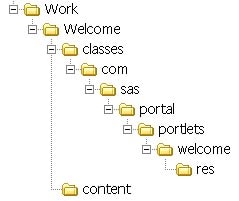| Directory |
Contents |
Work (root)
This directory serves as a development area for the portlet. |
Portlet deployment descriptor file portlet.xml
The name of the portlet deployment descriptor file must be portlet.xml.
|
/Welcome
|
This is the main portlet directory. It does not contain any files. The directory name must not have any spaces, and it must match the name of the portlet as specified in the name attribute of the <local-portlet> element in portlet.xml.
|
| /Welcome/classes |
Display resource files:
portletDisplayResources_de.properties, portletDisplayResources_en.properties, portletDisplayResources_es.properties, and so on. |
/Welcome/classes/com/sas/portal/
portlets/welcome |
The action class called WelcomeAction.class.
|
/Welcome/classes/com/sas/portal/
portlets/welcome/res |
Resource bundles:
Resources.properties, Resources_de.properties, Resources_es.properties, Resources_fr.properties, and so on.
Note: Alternatively, the resource bundles could be placed in the same directory as the action class.
|
| /Welcome/content
|
This directory contains the display page called Welcome.jsp.
Each portlet can have only one content location directory, and the directory name must be content. However, the content location directory can have an unlimited number of subdirectories. |
